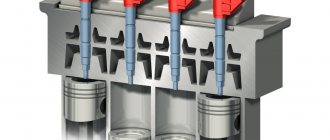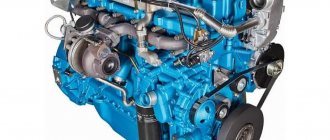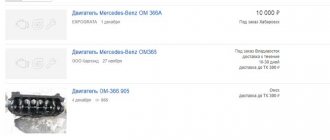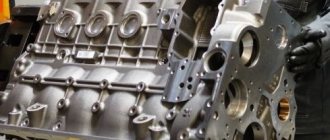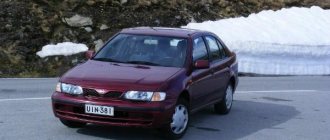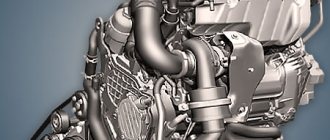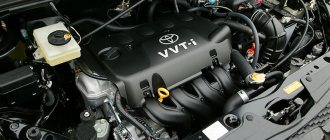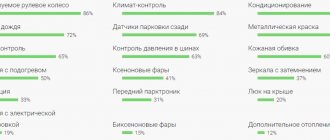Volvo VNL tractor: American beauty
come back
In 1997, Volvo launched a new series of Volvo VN tractor units. This is how the Volvo VNL tractor and its twin, the VNM, appeared.
The vehicles are built on previous designs from Volvo in the USA and on the proven FH12 wheelbase.
An attempt to integrate European standards into American developments led to success, and VN tractors are still one of the most recognizable vehicles among North American truckers.
The VN series vehicles were intended for towing cargo weighing 36 - 57 tons. Maximum speed is 103 km/h. The year of birth of the Volvo VNL tractor can be considered 1997, but at first the vehicles were supplied exclusively to the markets of Canada and the USA. The Europeans themselves saw the model only in 2003.
The last letter in the truck name indicates the length of the vehicle. The VNL and VNM models differ in the length of their hoods and the distance from the edge of the front bumper to the rear wall of the cab (2870 and 3124 mm, respectively). The difference is also evident in the engines, whose power ranges from 284 to 557 hp.
First generation Volvo VNL
The first generation VNL replaced the WIA and WCA series tractors. The entire VN series is presented as truck tractors and is designed for towing cargo over any distance. Such serious goals also determine engine power.
Serial power units of the Volvo VNL tractor include twelve-liter VED 12 diesel engines with a power of 431, 390 and 349 hp, as well as mechanical 14-speed gearboxes.
To order, you can install any engines and gearboxes from specialized companies designed for tractors of this type.
The VN series is offered with a “day” short cab, as well as with additional living or sleeping compartments with a length of 104, 155 and 195.6 centimeters. Moreover, the combined living compartment and cabin have improved suspension, noise insulation and a high-strength frame that does not allow the tractor to become severely deformed when turning over.
Second generation Volvo VNL
The main line of development of the company is directly related to the study of new types of fuel. The VN series is no exception, although most of the new products come from the VNX.
In the coming years, Volvo Trucks will introduce engines running on alternative fuels to the public.
The company plans to have trucks running on dimethyl ether, an energy-efficient fuel that has virtually no impact on the environment.
Today, dimethyl ether is used throughout the world, but not as a fuel. In addition, DME is produced from non-renewable and renewable resources (biomass). The company's decision is based on years of development, the results of field tests and interactions with fuel manufacturers and scientists. DME technology will be introduced in the Volvo VNL DME series with the D13 engine.
Volvo VNL 300
In 2013, at an exhibition held in the American city of Louisville, a new engine of the D13-LNG series was presented - a motor running on liquefied gas. The new engine is 20% more economical than other gas engines, and even more economical than diesel engines. Volvo has proposed another engine option running on compressed gas (CNG - compressed natural gas).
Technical characteristics and maintenance of Volvo Penta engines
The Swedish company Penta was founded in 1907 in the city of Skövde; the company initially specialized in the production of engines for ships. Currently, the concern produces motors for boats and industrial marine power plants using diesel fuel.
In this article we will look at what Volvo Penta engines are produced, how much they cost, and provide some technical characteristics.
A little history
At first, the Volvo Penta company was a factory for the production of agricultural implements; threshers and plows were manufactured at the enterprise. In 1907, the first diesel engine was assembled; 5 engineers took part in its creation (hence the name “Penta”).
In 1925, Penta was given an order to supply engines for cars, and ten years later the Volvo concern bought out the production, and since that time a merger has taken place - today Penta supplies power units and installations for the entire united Volvo group.
Nowadays, the Volvo Penta engine line includes both diesel engines of varying power (from 10 to 900 horsepower) and gasoline engines with pumps. The company has a well-developed dealer network, with four thousand representatives around the world.
Volvo Penta gasoline engines for boats
Volvo Penta gasoline engines for pleasure boats and yachts are equipped with tilting propellers and have gained popularity due to their excellent performance and economical fuel consumption.
The line of power units includes engines with volumes from 3.0 to 8.1 liters, with power from 125 to 420 horsepower. The engines come with DPS and SX steering column models.
Additionally, the engines can be equipped with 2-circuit cooling; the system increases the resource of the power unit.
4.3GXiE engine specifications:
- number of cylinders – six;
- piston stroke/cylinder diameter – 88.4/101.6mm;
- working volume – 4.3 l;
- power – 225 l. With. (or 168 kW);
- maximum speed – 4800 per minute;
- compression ratio – 9.4.
The torquey and very powerful 8.1 liter GXiE engine is equipped with a speed tracking system and a catalyst that allows you to work with full efficiency even if the quality of Russian fuel is not high enough.
Electronic motor control ensures maximum power output, and the electronic system can be controlled from a mobile phone device. The eight-cylinder power unit develops power up to 420 hp. With.
at a maximum rotation speed of 5 thousand revolutions per minute.
The most compact in the line of Volvo Penta gasoline engines is the 3.0-liter power unit. This engine is an inline four-cylinder and can be an excellent replacement for an outboard engine on a pleasure boat. Volvo Penta 3.
0GL features low noise and low vibration, mounted with a single screw and SX type rotary column. Maximum engine speed is 4600 per minute, installation power is 125 hp. With.
Modifications
The motor has the following versions:
- D4192T2 - 90 l. With. power and 190 Nm of torque, compression ratio 19 units;
- D4192T3 - 115 l. With. and 256 Nm of torque;
- D4192T4 - 102 l. With. and 215 Nm of torque.
| Engine make | F8Q | F8Qt |
| Nutrition | diesel | diesel |
| Layout | in-line | in-line |
| Working volume, cm3 | 1870 | 1870 |
| Number of cylinders/valves | 4/2 | 4/2 |
| Piston stroke, mm | 93 | 93 |
| Cylinder diameter, mm | 80 | 80 |
| Compression ratio, units | 21.5 | 20.5 |
| Engine power, l. With. | 55-65 | 90-105 |
| Torque, Nm | 118-123 | 176-190 |
| Crab | V40 98` 1.9TD (D4192T) after replacing the timing belt (new kit) 60 thousand. Do I need to change the timing belt or does it go up to 90 thousand? |
| Bevar | I have 40 thousand, still like new |
| Brain | For Renaults with this engine, the replacement interval is 75 thousand. For Volvo 90 thousand. I changed it to 60 |
| Bradmester | my advice is to change it and don’t think about it, it’s better to pay a little extra now than to pay a tidy sum later, 60 thousand is the mileage, my belt is running 50, I’ll change it immediately (this is not a suspension where you have to think a hundred times before throwing out your original and installing all sorts of crap) , but the zanys will come from the existential... |
| Crab | How to properly drain condensate from a fuel filter (knecht KC76) 1.9 TD (D4192T)? |
| Brain | You unscrew the plug from below and it drains. |
| Crab | Should I unscrew the plug completely? do you need to pump? |
| Brain | Unscrew it completely, drain the condensate, screw it back on. There is no need to pump anything. I drained it and moved on. |
| Crab | I unscrewed the cap... it seemed like pure diesel fuel poured out, it drained for about 10 seconds and continued on, I didn’t wait any longer and turned it back! how much should I drain? |
| Brain | In 2-3 seconds the water goes away and that’s it. Maybe you unscrewed it while it was running? |
| Crab | no, not when it was running - I completely unscrewed the plug at the bottom of the filter and diesel fuel began to flow.... so drain mono and liters |
| Sikeman | Please tell me a service station that understands Renault diesel engines. I need to change the timing belt soon and I want to carry out diagnostics - the lambda was on several times at high speed, and the engine began to rumble at over 70 km/h. |
| Semak | about the error, probably only for the elites, because the car is 98g, but I wouldn’t recommend it, it’s just that if the error comes on at high speed and is not registered in the computer, then the elite will not help, they just drive the car and read the errors registered in the computer, and no one will overclock the car. I'm getting a fanoma error, at the elite they showed me a fig and asked me to pay 47 thousand for this fig |
| Mihai | Tell me, my friend, the numbers of the rollers and timing belt for the 1.9 diesel engine. for V40, 01 vin YV1VW78821F766201 and it’s already gone, some say 1 video, some say two! Is it also better to change the pump right away? |
| Stingray | I have a suspicion that the turbine does not turn on, there is no pick-up at all after 2 thousand, I can’t hear any whistle, and the engine won’t spin beyond 3 thousand, how can I check the operation of the turbine, what kind of valve is screwed up? The only thing I have managed so far is to touch the pipes going to the intercooler; as the speed increases, it becomes impossible to compress the pipes, which means it looks like the turbine is driving air. I think it might actually be a catalyst... |
| Gor67 | It seems to work all the time for you, just as it does for me. On diesel magpies, all turbines seem to be like this (at least the engines (D4192T and D4192T2) |
| Dimos | turbines on all cars work from the moment the engine starts, just at idle the turbine does not pump air, but only mixes it after the air filter |
| Gor67 | If my memory serves me correctly from what was explained to me, there are high-pressure turbines (which operate at 2500-3000 rpm), and low-pressure turbines (which operate constantly). The cars mentioned above have low pressure. |
| Dimos | They do not work, but provide a noticeable increase in engine power and torque. |
| Vitalich | air definitely, maybe also spark plugs, look at the air from the filter to the pump, you can temporarily install transparent hoses IMHO |
| Sikeman | there is a nipple on the fuel injection pump, if you look at it, it’s from the front, you just loosen it and pump the system until the diesel fuel comes out |
| Sensors | coolant temperature, air temperature, engine speed, vehicle speed, start of injection |
| Controlled by ECU | high pressure fuel pump, high-altitude corrector via relay, injection advance solenoid valve, cold engine start system, exhaust gas recirculation system, injection system failure lamp, preheating system lamp, fast idle air control solenoid valve |
| What can be replaced in the injection pump | load potentiometer, injection advance solenoid valve, height corrector, shut-off solenoid valve |
Engine Volvo TAD1252VE
Stationary Volvo Penta TAD1252VE industrial diesel engines are installed on equipment and machinery that meets the requirements of Stage 3A / Tier 2 environmental standards. Volvo TAD1252VE diesel engines for industrial installations are used for work in confined spaces, have small overall dimensions combined with high power.
Volvo TAD1252VE is a six-cylinder diesel engine for industrial installations and machinery. Volvo TAD1252VE has a small size, which makes it convenient for both equipment manufacturers and maintenance.
Each Volvo Penta engine has a compact design, is manufactured using new casting technology and innovative engineering, advanced electronic control systems and strict environmental safety standards.
We offer to purchase an industrial Volvo Penta engine as a complete new one, as well as Volvo components and spare parts for the diesel engine you need.
In our company you can buy a Volvo Penta TAD1252VE engine at a competitive price. You can submit an application for the necessary Volvo motor equipment on the specialized Order page or by calling the numbers listed on the Contacts page.
Industrial diesel engines Penta are manufactured in factories in Germany (D5-D7), France (D9), Sweden (D12-D16).
- Specifications
- Instructions
- Control system
- Spare parts
The specifications presented in the table are for reference only and are subject to change without notice.
| Technical data of Volvo TAD1252VE diesel for industrial installations | |
| Model | TAD1252VE |
| Power at 1800 rpm, kW (hp) | 313 (426) |
| Torque at 1200 rpm, Nm | 1760 |
| Number of cylinders | 6 |
| Cylinder diameter, mm | 131 |
| Piston stroke, mm | 150 |
| Cylinder volume, l | 12.13 |
| Compression ratio | 18,1:1 |
| Dimensions L×H×H, mm | 1497×854×1199 |
| Dry weight, kg | 1270 |
The TAD1252VE electronic control system continuously monitors and receives data from multiple sensors in the engine, and instantly adjusts fuel delivery and injection timing accordingly. This maximizes fuel efficiency and engine power at any load and reduces response time to changes in fuel supply.
Volvo TAD1252VE spare parts catalog You can find Volvo TAD1252VE spare parts on the page Our company monitors the operation and maintenance of Volvo industrial engines and is always ready to supply a full range of components. From us you can wholesale and retail buy Volvo spare parts. The price and delivery time are minimal.
Delivery is carried out by transport companies throughout the Russian Federation.
Source: https://www.volvo-motor.ru/production/penta-industrial/tad1252ve.html
Engine SC9D220G2B1 (original)
We make calculations and place orders by e-mail or by phone.
Engine SC9D220G2B1 (original). Power 162 kW, 2200 rpm. Warranty 12 months or 2000 operating hours. Our company supplies only original engines for Chinese special equipment to the Russian market. Official factory guarantee. Unit passport. We send orders to all cities of Russia through transport companies. We deliver goods to TK terminals for free.
Contract engine d4164t 39908
Experts viewed the launch of the d4164t series of engines by the Volvo concern in 2005 with some doubt. This was facilitated by the modest parameters of the power unit, because the Swedes did not yet have small diesel engines. Or rather, they were, but only as joint developments.
Technical capabilities
The doubts of the experts turned out to be unfounded, because the d4164t was no exception. In fact, Peugeot designers took the main part in its creation, while Volvo and Ford were content with only minor modifications. However, owners of as many as 5 model series Volvo V50, V70 third generation, S40 and S80 second generation and also C30 may need to buy the d4164t engine.
The inline 4-cylinder engine has a volume of 1.6 liters and a power of 109 hp. To achieve high dynamics with a small volume, the developers used:
- 2 overhead camshafts;
- 16 valves;
- Garrett turbocharger;
- Common Rail fuel supply;
- fuel filter with thermoelement;
- exhaust gas recirculation valve system;
- ECM control module.
Possible technical problems
Experienced motorists have few complaints about the d4164t engine. It has a long service life and exceeds 500 thousand km, but only if the car is properly maintained. And this:
- compliance with manufacturers' recommendations for consumable fuels and lubricants;
- regular maintenance;
- timely replacement of filters and timing parts.
Among the most common malfunctions of this unit are problems with the turbine. Motorists criticize its tendency to take in additional air from outside (overblowing) and become coked. But, as practice shows, the problem can be easily solved by selecting another turbine.
There are many complaints about the EGR valve. Its membrane is very delicate, and therefore often fails. To avoid problems with the valve, the inlet should be cleaned regularly.
The d4164t turned out to be capricious in terms of fuel quality and really loves high-quality diesel fuel. In this regard, car owners are advised to refuel only at those gas stations that value their reputation and monitor the quality of the fuel supplied.



